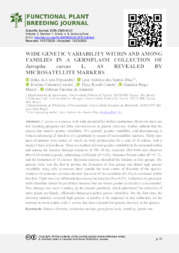Wide genetic variability within and among families in a germplasm collection of jatropha curcas l. as revealed by microsatellite markers.
Wide genetic variability within and among families in a germplasm collection of jatropha curcas l. as revealed by microsatellite markers.
Autoria: FERNANDES, E. da C.; DIAS, L. A. dos S.; CAIXETA, E. T.; CORRÊA, T. R.; MUNIZ, D. R.; ALMEIDA, O. F. de
Resumo: J. curcas is a species with wide potential for biofuel production. However, there are few breeding programs and little information on its genetic structure. Studies indicate that the species has narrow genetic variability. We quantify genetic variability, and decomposing it within and among 28 families of a genebank by means of microsatellite markers. Thirty-nine pairs of primers were tested, of which six were polymorphic for a total of 18 alleles, with a mean of three alleles/locus. These six markers allowed genetic variability to be estimated within and among the families through estimates of PIC (0.36), expected (He=0.44) and observed (Ho=0.48) heterozygosity, inbreeding coefficient (f=-0.03), Shannon-Wiener index (H?=0.71), and the formation of 11 clusters. Bayesian analysis classified the families in four groups. The present study was the first to portray the formation of four groups and detect high genetic variability using only accessions from outside the main center of diversity of the species. Analysis of molecular variance showed that most of the variability (92.4%) is contained within families. There was low differentiation among the families (FST=0.07). Collection of genotypes within families should be prioritized because they are where greater variability is concentrated. This strategy was used in setting up the present genebank, which prioritized the collection of more plants per family, efficiently bringing together greater variability. For the first time, the diversity statistics revealed high genetic variability to be exploited in this collection, on the contrary to most studies with J. curcas that have claimed low genetic diversity in the species.
Ano de publicação: 2021
Tipo de publicação: Artigo de periódico
Unidade: Embrapa Café
Observações
1 - Por padrão são exibidas publicações dos últimos 20 anos. Para encontrar publicações mais antigas, configure o filtro ano de publicação, colocando o ano a partir do qual você deseja encontrar publicações. O filtro está na coluna da esquerda na busca acima.
2 - Para ler algumas publicações da Embrapa (apenas as que estão em formato ePub), é necessário ter, no celular ou computador, um desses softwares gratuitos. Sistemas Android: Google Play Livros; IOS: iBooks; Windows e Linux: software Calibre.
Acesse outras publicações
Acesse a Base de Dados da Pesquisa Agropecuária (BDPA) para consultar o acervo completo das bibliotecas da Embrapa.

